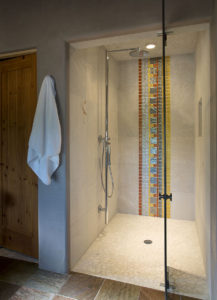Candy Shop

Fortunately, for any interior design project, there are nearly endless resources for almost any idea. It’s like an enormous candy shop, and the question is always the same: how to choose; how to find the right new thing while staying true to your personal storyline. This month, we’re going on a field trip to an interior design library—and then further abroad—to explore available resources, and how to use them.
Every interior design library is different. At the heart of this one is a small one-window room that houses catalogs and finish samples—floor to ceiling—organized and updated daily. The designers have labeled shelves by product category and type: 30 linear feet of indoor furniture binders (separated by contemporary, transitional, and traditional styles); 13 linear feet of outdoor furniture catalogs; 12 linear feet of lighting catalogs; 6 linear feet of accessories and art; as well as shelves of loose stone, plaster, metal, wood, and glass samples. On another wall, one finds wall covering samples sorted by whether they’re for commercial or residential projects; stacks of large boxes filled with fine leathers; rows of carpet books; and full sets of paint books from the four leading vendors. On an opposite wall, shimmering chains of finish samples—by vendor—hang on pegboard.
Just outside this room is a larger space with sixteen square metal baskets containing patterned (i.e. printed, embroidered, woven) fabric samples—mini works of art in their own right—sorted by dominant color, and collected from leading textile houses. In this same room, books of more basic fabrics (solids and textures) hang several deep on a long wall that also has an area for rings of commercial fabrics, segregated by durability and flammability (useful for many commercial projects). Adjacent to this area are rings upon rings of loose samples with solid-colored textured fabrics grouped by color.
If this part of the tour threatens dizziness, don’t panic, there’s assistance at hand. Professional interior designers have a practiced ability to scan catalogs quickly, pulling selections, and rifling through fabric bins to find gems that will support the story you’re trying to tell. It’s a key part of the job, and most are very, very good at it.
Many firms now also have a digital library containing links to manufacturer’s online catalogs, and trade periodicals and trade shows also offer place to look for the new and interesting.
Most major U.S. cities have a design center. Some are open to the public, but most are set aside for professionals. Inside, you’ll find multiple complimentary product lines on display, so that one can see furniture, fabric, trim, lighting, etc. all in one place. Designers use these showrooms to ‘shop’ for a project, either by themselves or with their clients, to see what’s available and to test drive furniture and finishes. Like the libraries, these showrooms can be overwhelming, but trust your designer’s experience.
Then there’s the designer’s private ‘black book’ of favorite workrooms, blacksmiths, decorative painters, steel fabricators, woodworkers, furniture makers, concrete fabricators, stone workers, and so on. These artisans’ workshops provide inspiration and limitless possibilities, as well as the chance for something utterly unique.
Clearly, there are a lot of resources out there to bring your story to life in a unique and life-enriching way. But the most important of these is your designer. Through ruthless editing, he or she can turn what you can see as the overwhelming into a set of choices that are reliable, durable, as well as appropriate for your budget, timeline, and story.
Next up: the nitty gritty in the design process, where drawings take the form of Construction Documents and budgets.


